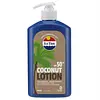What's inside
What's inside
 Key Ingredients
Key Ingredients

 Benefits
Benefits

No benefits
 Concerns
Concerns

 Ingredients Side-by-side
Ingredients Side-by-side

4-Methylbenzylidene Camphor
UV AbsorberButyl Methoxydibenzoylmethane
UV AbsorberEthylhexyl Triazone
UV AbsorberOctocrylene
UV AbsorberC12-15 Alkyl Benzoate
AntimicrobialAloe Barbadensis Leaf Juice
Skin ConditioningCaprylyl Glycol
EmollientCarbomer
Emulsion StabilisingTocopheryl Acetate
AntioxidantGlycerin
HumectantHydroxyethylcellulose
Emulsion StabilisingColloidal Oatmeal
AbsorbentCaprylic Acid
CleansingPEG-15 Cocamine
EmulsifyingPEG-40 Stearate
EmulsifyingWater
Skin ConditioningSilicon
AbrasiveTriethanolamine
BufferingBeeswax
Emulsion Stabilising4-Methylbenzylidene Camphor, Butyl Methoxydibenzoylmethane, Ethylhexyl Triazone, Octocrylene, C12-15 Alkyl Benzoate, Aloe Barbadensis Leaf Juice, Caprylyl Glycol, Carbomer, Tocopheryl Acetate, Glycerin, Hydroxyethylcellulose, Colloidal Oatmeal, Caprylic Acid, PEG-15 Cocamine, PEG-40 Stearate, Water, Silicon, Triethanolamine, Beeswax
 Reviews
Reviews

Ingredients Explained
These ingredients are found in both products.
Ingredients higher up in an ingredient list are typically present in a larger amount.
This ingredient is a camphor derivative that offers UV-B (290-320 nm) protection. It is both a UV absorber and filter.
4-Methylbenzylidene Camphor is approved in the EU and Canada. It is not approved in the US and Japan.
Also known as Avobenzone, this ingredient is a chemical sunscreen filter that provides protection in the UV-A range.
Avobenzone is globally approved and is the most commonly used UV-A filter in the world.
Studies have found that avobenzone becomes ineffective when exposed to UV light (it is not photostable; meaning that it breaks down in sunlight). Because of this, formulations that include avobenzone will usually contain stabilizers such as octocrylene.
However, some modern formulations (looking at you, EU!) are able to stabilize avobenzone by coating the molecules.
Avobenzone does not protect against the UV-B range, so it's important to check that the sunscreen you're using contains other UV filters that do!
The highest concentration of avobenzone permitted is 3% in the US, and 5% in the EU.
Learn more about Butyl MethoxydibenzoylmethaneOctocrylene protects skin from sun damage. It absorbs UV-B with peak absorption of 304 nm. It is a common sunscreen ingredient and often paired with avobenzone, a UVA filter. This is because octocrylene stabilizes other sunscreen ingredients by protecting them from degradation when exposed to sunlight. Octocrylene is a photostable ingredient and loses about 10% of SPF in 95 minutes.
Octocrylene also acts as an emollient, meaning it helps skin retain moisture and softens skin. It is oil-soluble and hydrophobic, enhancing water-resistant properties in a product.
Those who are using ketoprofen, a topical anti-inflammatory drug, may experience an allergic reaction when using octocrylene. It is best to speak with a healthcare professional about using sunscreens with octocrylene.
The EU allows a maximum of these concentrations:
Learn more about Octocrylene